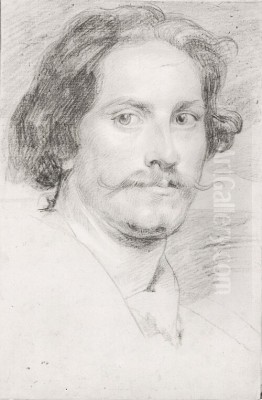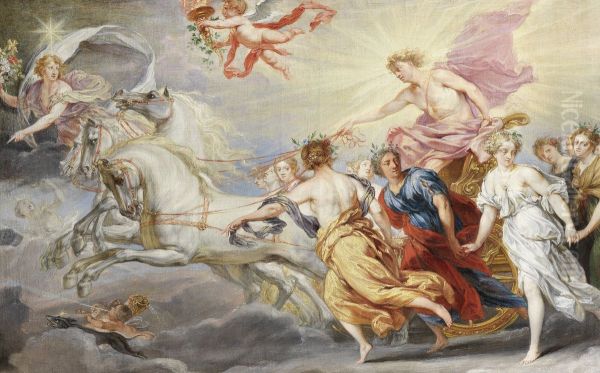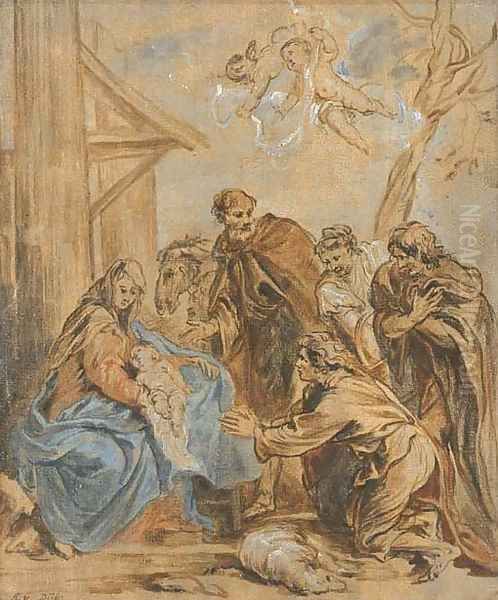
Jan Boeckhorst, also known by the German form of his first name, Johann, and affectionately nicknamed "Lange Jan" (Tall John) due to his notable height, stands as a significant, albeit sometimes overlooked, figure in the vibrant tapestry of 17th-century Flemish Baroque art. Born in 1604 in Münster, Westphalia (then part of the Holy Roman Empire, now Germany), and passing away in Antwerp in 1668, Boeckhorst carved out a distinguished career as a painter and draughtsman, adept in historical subjects, religious scenes, portraiture, and genre painting. His life and work are intrinsically linked with the artistic powerhouse of Antwerp, particularly with the towering figures of Peter Paul Rubens, Anthony van Dyck, and Jacob Jordaens.
Early Life and Artistic Awakening in Münster and Antwerp
Jan Boeckhorst was born into a respectable and relatively affluent family in Münster. He was the second son of Heinrich Boeckhorst, a lawyer and onetime mayor of Münster, and Katharina Helskamp. His elder brother, Heinrich the Younger, would also pursue a legal career and become a prominent citizen. Initially, Jan Boeckhorst's path did not seem destined for the arts. At the age of seventeen, around 1621, he became a novice in the Jesuit order. However, his religious vocation was apparently short-lived, or perhaps his artistic inclinations proved stronger.
By the age of twenty-two, around 1626, Boeckhorst had made a pivotal decision to pursue an artistic career. This led him to Antwerp, the undisputed artistic capital of Northern Europe at the time. The city was a magnet for aspiring artists, primarily due to the overwhelming presence and influence of Peter Paul Rubens. It is highly probable that Boeckhorst sought out the best possible training, and while direct pupilage under Rubens is debated by some scholars, the stylistic and thematic impact of the master is undeniable in Boeckhorst's oeuvre. He is also believed to have studied or worked closely with Jacob Jordaens, another leading figure in Antwerp's art scene, and certainly developed a close working relationship with Anthony van Dyck.
The Antwerp Milieu: Influences and Collaborations

Antwerp in the 1620s and 1630s was a crucible of artistic innovation and production, largely dominated by the personality and workshop of Peter Paul Rubens. For a young artist like Boeckhorst, arriving from Germany, the environment must have been both daunting and exhilarating. He quickly assimilated the prevailing artistic language, which was characterized by dynamic compositions, rich colors, dramatic lighting, and a profound understanding of human anatomy and emotion – all hallmarks of Rubens's style.
Boeckhorst's connection with Rubens was profound. He is documented as a collaborator in Rubens's studio, particularly in the later 1630s. This was a common practice; Rubens managed a large workshop that produced an immense volume of work, relying on talented assistants and collaborators to execute various parts of large commissions, from initial sketches to final paintings, and to create replicas or variations of successful compositions. Boeckhorst's skill was such that he was entrusted with significant tasks, including completing works left unfinished by Rubens after the master's death in 1640.
His relationship with Anthony van Dyck was also significant. Van Dyck, though often abroad, had a profound impact on portraiture and religious painting in Antwerp with his elegant figures and refined psychological insight. Boeckhorst's portraits, while retaining a Rubensian robustness, often show a sensitivity and grace that may reflect Van Dyck's influence. Indeed, some sources suggest a period of direct collaboration or at least close artistic exchange between the two.
Jacob Jordaens, the third major figure of the Antwerp school after Rubens and Van Dyck, also left his mark. Jordaens's more robust, earthy, and often boisterous style, particularly evident in his genre scenes and large-scale mythological and religious works, can be seen as another strand in the complex web of influences that shaped Boeckhorst. Boeckhorst's own genre scenes, though less numerous, share some of this Flemish vitality.
The Guild of Saint Luke and Early Commissions
A crucial step in any artist's career in Antwerp was becoming a master in the Guild of Saint Luke, the city's official organization for painters, sculptors, and other craftsmen. Boeckhorst achieved this status in the guild year 1633-1634. Membership conferred legitimacy and the right to take on pupils and sell work independently. This milestone indicates that by his late twenties, Boeckhorst was recognized as a skilled and independent artist.

His talent did not go unnoticed, and he began to receive important commissions. One notable early project involved a series of twenty-six biblical scenes for the Falcon Monastery in Antwerp. While he designed these, the actual execution of some may have been completed by other artists after his initial work. Such large-scale decorative schemes were common, often adorning churches, monasteries, and public buildings, and they provided significant opportunities for artists to showcase their abilities in narrative composition and dramatic expression. These commissions were vital for establishing an artist's reputation and securing further patronage.
Italian Sojourns and Their Impact
Like many Northern European artists of his time, Boeckhorst understood the importance of experiencing Italian art firsthand. Italy, particularly Rome, Venice, and Florence, was considered the wellspring of classical and Renaissance art, essential for any artist aspiring to a grand manner. Boeckhorst undertook at least two significant journeys to Italy.
His first extended trip occurred between 1635 and 1637. During this period, he is known to have visited Genoa, a city with strong artistic and commercial ties to Flanders, and Venice. In Venice, he would have immersed himself in the works of the great Venetian colorists – Titian, Paolo Veronese, and Jacopo Tintoretto. The Venetian emphasis on rich color, atmospheric effects, and dynamic compositions would have resonated with his Antwerp training and further enriched his palette and compositional strategies.
He traveled to Rome in 1637, the heart of the classical world and a vibrant center for contemporary Baroque art, where artists like Gian Lorenzo Bernini and Pietro da Cortona were active. In Rome, he would have studied ancient sculpture, the masterpieces of Raphael and Michelangelo, and the powerful works of Caravaggio and his followers, as well as the classicizing trends of Annibale Carracci and Domenichino.
A second visit to Rome is documented in 1639. These Italian experiences were transformative. They broadened his artistic horizons, refined his understanding of classical form and ideal beauty, and exposed him to different approaches to narrative and expression. The influence of Italian art, particularly the Venetian school's handling of color and light, is discernible in his subsequent work, adding a layer of sophistication and warmth to his Flemish foundations. It's also noted that during one of these Italian trips, he was involved in creating mythological paintings for King Philip IV of Spain's hunting lodge, the Torre de la Parada, a project largely overseen by Rubens, indicating his continued connection to the master's major international commissions.
Artistic Style and Thematic Concerns
Jan Boeckhorst was a versatile artist, proficient across several genres, a common trait among successful Flemish Baroque painters who needed to cater to diverse market demands.
History Painting: This was considered the noblest genre, encompassing biblical, mythological, and historical subjects. Boeckhorst excelled in creating large-scale, multi-figured compositions filled with drama and emotion. His works often feature dynamic movement, expressive figures, and a rich, warm palette. He skillfully managed complex narratives, conveying the story's emotional core through gesture, facial expression, and the interplay of light and shadow. His style here is deeply indebted to Rubens, but often with a slightly softer, more elegant touch, perhaps reflecting Van Dyck or his Italian studies.
Religious Art: A significant portion of Boeckhorst's output consisted of religious paintings, including numerous altarpieces for churches and monasteries in Flanders and Germany. These works were central to the Counter-Reformation's efforts to use art to inspire piety and affirm Catholic doctrine. Boeckhorst's religious scenes are characterized by their devotional intensity, clear storytelling, and often, a tender humanism. Works like The Triumphant Christ Forgiving Repentant Sinners showcase his ability to convey profound theological concepts with visual power and emotional resonance.
Portraiture: Boeckhorst was also an accomplished portraitist. His portraits combine the Flemish tradition of detailed realism with a Baroque sense of presence and vitality. He captured not only the likeness of his sitters but also a sense of their status and personality. His approach to portraiture shows the influence of Van Dyck's elegance, but often with a more direct and less idealized presentation.
Genre Scenes: While not his primary focus, Boeckhorst also produced genre paintings, depicting scenes of everyday life, often with peasants or market scenes. These works, such as Cook at a Kitchen Table with Goats and Pheasants, demonstrate his keen observation skills and his ability to imbue ordinary subjects with a lively charm. They connect to a broader Flemish tradition exemplified by artists like Adriaen Brouwer and David Teniers the Younger, though Boeckhorst's treatment is generally more polished.
Tapestry Design and Graphic Work: Boeckhorst was also active as a designer of tapestries, a highly prestigious and lucrative art form in Flanders. Tapestry workshops in Brussels, Antwerp, and Oudenaarde were renowned throughout Europe. Designing cartoons (full-scale models) for tapestries required a strong sense of composition and narrative, skills Boeckhorst possessed in abundance. He created designs for series such as the story of Anton van Leyen. Furthermore, he produced drawings that were translated into prints, helping to disseminate his compositions to a wider audience.
Master of Collaboration: Working with and for Rubens
Boeckhorst's relationship with Peter Paul Rubens was arguably the most formative of his career. He was not merely a pupil but a trusted collaborator. This is evident from his involvement in major projects originating from Rubens's workshop, such as the decorations for the triumphal entry (Pompa Introitus Ferdinandi) of Cardinal-Infante Ferdinand into Antwerp in 1635, and the mythological series for Philip IV's Torre de la Parada.
After Rubens's death in 1640, Boeckhorst's skills and his intimate knowledge of Rubens's style led him to be commissioned to complete several of the master's unfinished works. This was a testament to his ability to emulate Rubens's manner so convincingly that the transition between the master's hand and his own was often seamless. One famous example is King David Playing the Harp, where Rubens had painted the upper portion, and Boeckhorst is credited with completing the lower part, transforming it into a full-length figure. He is also believed to have worked on or completed versions of Rubens's The Fall of the Damned. This role as a finisher of Rubens's legacy further solidified his reputation.
Beyond Rubens, Boeckhorst collaborated with other specialists, a common practice in Antwerp. For instance, still life or animal painters might contribute specific elements to a larger historical or mythological scene. Artists like Frans Snyders, renowned for his animals and market scenes, or Jan Wildens, a landscape specialist, frequently collaborated with figure painters. While specific collaborations of this nature for Boeckhorst are less documented than for Rubens, the environment fostered such teamwork. He certainly worked alongside other figure painters in Rubens's studio, such as Erasmus Quellinus II, Theodoor van Thulden, and Cornelis Schut, all contributing to the massive output of the workshop.
Key Representative Works
Several works stand out in Jan Boeckhorst's oeuvre, showcasing his diverse talents:
"The Four Continents" series: This allegorical series, depicting personifications of Europe, Asia, Africa, and America, was a popular theme in Baroque art, allowing for exotic imagery and complex symbolism. Boeckhorst's interpretations would have been rich in detail and vibrant in color, reflecting the era's burgeoning global awareness and colonial ambitions. His Allegory of Africa is a notable example, often characterized by its opulent figures and symbolic attributes.
"King David Playing the Harp" (with Rubens): Now in the Städel Museum, Frankfurt, this painting is a prime example of his ability to seamlessly continue Rubens's work. The majestic figure of David, imbued with spiritual intensity, demonstrates the powerful synthesis of their styles.
"The Triumphant Christ Forgiving Repentant Sinners": This work exemplifies his skill in religious narrative, conveying a message of redemption and divine mercy with dramatic force and emotional depth. The composition would likely feature dynamic figures and a celestial radiance typical of Counter-Reformation imagery.
"Phoebus Apollo" (c. 1668): Housed in The Phoebus Foundation, this late work likely depicts the sun god with characteristic Baroque dynamism and idealized classical form, showcasing his enduring skill even towards the end of his life.
"Cook at a Kitchen Table with Goats and Pheasants" (c. 1636-37): In the Museum of Fine Arts, St. Petersburg, Florida, this painting highlights his ability in genre scenes, combining lively figures with well-rendered still life elements.
Epitaph of Maria Snyders: This altarpiece, created for the tomb of the wife of the famous still-life painter Frans Snyders (now in LACMA), underscores his role in creating significant commemorative works for prominent Antwerp citizens.
Designs for the Falcon Monastery: The twenty-six biblical scenes he designed for this Antwerp institution, even if executed by others, represent a major early undertaking that would have established his reputation for large-scale narrative cycles.
Later Career, Recognition, and "Lange Jan"
Boeckhorst returned to Antwerp in the early 1640s after his Italian travels, his style enriched and his reputation growing. He continued to receive important commissions for altarpieces and other religious works from churches and monastic orders in Antwerp, Bruges, Ghent, and his native Münster. His productivity remained high throughout the 1640s and 1650s.
His fame extended beyond the Low Countries. In 1649, he received a prestigious invitation to become court painter to Queen Christina of Sweden in Stockholm. Christina was a renowned patron of the arts and sciences, and such an appointment would have been a significant honor. However, Boeckhorst ultimately declined the offer, choosing to remain in Antwerp, which was still a thriving artistic center, and where he had deep personal and professional roots. This decision speaks to his established position and contentment within the Antwerp art world. Other artists who did work for Queen Christina included David Beck.
His nickname, "Lange Jan" or "Langen Jan" (Tall John), was widely used and appears in contemporary documents. This moniker, stemming from his impressive physical stature, made him a recognizable figure in Antwerp's artistic community. It adds a personal touch to our understanding of the artist, suggesting a man of notable presence.
He remained active late into his life, continuing to create powerful religious works. He passed away in Antwerp on April 21, 1668, and was buried in the St. James' Church, the same church that houses Rubens's funerary chapel – a fitting final resting place for an artist so closely associated with the master.
Boeckhorst's Works in Public Collections
Today, Jan Boeckhorst's paintings and drawings are held in numerous prestigious museums and collections across Europe and North America, a testament to his enduring artistic value. Key institutions include:
Royal Museums of Fine Arts of Belgium, Brussels: Holds a significant collection of Flemish art, including works by Boeckhorst.
Royal Museum of Fine Arts, Antwerp (KMSKA): Naturally, this museum has a strong representation of Antwerp school painters.
Rubenshuis, Antwerp: While primarily dedicated to Rubens, it also features works by his collaborators and contemporaries, including modelli by Boeckhorst, such as one for The Daughters of Achilles among the Daughters of Lycomedes.
Städel Museum, Frankfurt am Main, Germany: Home to the famous King David Playing the Harp.
LWL-Museum für Kunst und Kultur, Münster, Germany: As a native son, his works are represented in his city of birth.
Alte Pinakothek, Munich, Germany: Holds a version of The Fall of the Damned attributed to Boeckhorst after Rubens.
Kunsthistorisches Museum, Vienna, Austria: Possesses a rich collection of Flemish Baroque paintings.
The Phoebus Foundation, Antwerp: A private collection with important Flemish art, including Boeckhorst's Phoebus Apollo.
Museum of Fine Arts, St. Petersburg, Florida, USA: Houses Cook at a Kitchen Table with Goats and Pheasants.
Los Angeles County Museum of Art (LACMA), USA: Holds the Epitaph of Maria Snyders.
Plantin-Moretus Museum, Antwerp: Contains drawings and sketches, some linked to Rubens's studio practices.
Suermondt-Ludwig Museum, Aachen, Germany: Holds tapestry designs by Boeckhorst.
Other artists whose works often appear alongside Boeckhorst's in these collections, reflecting the interconnectedness of the Antwerp school, include Gaspar de Crayer, a prolific contemporary altarpiece painter; Abraham Janssens, an important predecessor to Rubens in bringing Italianate styles to Antwerp; and later figures like David Teniers the Younger, who specialized in genre scenes.
Enduring Legacy
Jan Boeckhorst was a highly skilled and versatile artist who made significant contributions to Flemish Baroque painting. While often seen in the shadow of the colossal figures of Rubens and Van Dyck, he was a master in his own right, capable of producing works of great power, beauty, and emotional depth. His ability to absorb and synthesize various influences – the dynamism of Rubens, the elegance of Van Dyck, the robustness of Jordaens, and the colorism of the Venetians – resulted in a distinctive personal style.
His role as a collaborator and completer of Rubens's works underscores his technical mastery and his deep understanding of the High Baroque idiom. He successfully navigated the demanding art market of his time, producing a substantial body of work across multiple genres that catered to the needs of both ecclesiastical and private patrons. "Lange Jan" Boeckhorst remains an important figure for understanding the richness and complexity of art in 17th-century Antwerp, a vital contributor to the enduring legacy of the Flemish Baroque.